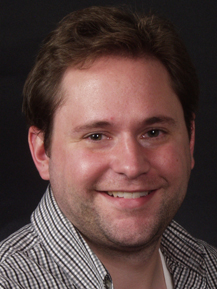Patrick Burton
- Associate Professor of Biology
- Hays Science Hall 222
- 765-361-6218
- burtonp@wabash.edu
- Curriculum vitae

I’m interested in questions related to the origin and evolution of animals body plans. Adult body plans arise through the process of development. Thus, I am interested in the evolution of developmental processes.
Why is it that some animals can develop their adult body plan multiple ways (e.g. embryonic, asexual, and regenerative development) while humans cannot? To address this question, I compare the molecular, cellular and genomic mechanisms by which a species of sea anemone (Nematostella vectensis) accomplishes these three modes of development. Students in my upper-level courses and working in my research lab investigate these questions through a mix of independent research, hands-on experimentation, and primary literature review.
Aside from my scientific interests, I am also a foodie and avid collector of rare and first edition books. My book collection includes works by Charles Darwin, Thomas Huxley, and other important biologists as well as modern fiction. My interest in food includes culinary adventures in the kitchen, artisanal cheeses, and fine wine (which I also collect).
Education
Ph.D. in Biology, Boston University, Boston, MA, May 2005
B.A. in Biology with Honors, Williams College, Williamstown, MA, May 2000
Recent Course Offerings
BIO 101: Human Biology
BIO 111: Introductory Biology
BIO 112: Introductory Biology
BIO 211: Genetics
BIO 314: Developmental Biology
BIO 371: Evolution of Developmental Mechanisms
BIO 401: Senior Seminar
Recent Presentations
Burton, P. Development of a Cnidarian Sea Anemone and the Evolution of Regeneration. Depauw University. February 16th, 2011.
Harmon,* S. and Burton, P. 2010. Three modes of development, one genome: Understanding the relationship among Embryogenesis, Regeneration, and Asexual Reproduction. Indiana State University. April 8th, 2010.
Burton, P. Induction of oral fates in Nematostella vectensis. Indiana University-Purdue University Indianapolis. October 16th, 2009.
Harmon,* S, Stefanik, D, and Burton, P. 2010. How many mouths are too many? Induction of oral fates in the cnidarian Nematostella vectensis. Society for Integrative and Comparative Biology.
Burton, P, Vick,* M, and Finnerty, J. 2009. Novel developmental mechanisms among embryogenesis, asexual fission, and regeneration in Nematostella vectensis. European Society for Evolutionary Biology.
Harmon,* S, Vick,* M, Tritle,* B, and Burton, P. 2009. Cell Death and Division during Regeneration in the Sea Anemone Nematostella. Society for Integrative and Comparative Biology.
*Wabash Student
Recent Publications
Burton, PM and Finnerty JR. 2009. Conserved and Novel Gene Expression between Regeneration and Asexual Fission in Nematostella vectensis. Dev. Genes Evol.
Burton, PM. 2008. Insights from diploblasts; the evolution of mesoderm and muscle. J of Exp Zool B: Mol Dev Evol, 310B:1, 5-14. [published online, 2006]
Reitzel, AR, Burton, PM, Krone, C, and Finnerty, JR. 2006. Comparison of developmental trajectories in the starlet sea anemone Nematostella vectensis: embryogenesis, regeneration, and two forms of asexual fission. Invertebrate Biology 126(2), 99-112.
Ryan, JF, Burton, PM, Mazza, M, Kwong, GK, Mullikin, JC, Rokhsar, DS, and Finnerty, JR. 2006. The cnidarian-bilaterian ancestor possessed at least 56 homeoboxes. Evidence from the sequenced genome of the starlet sea anemone, Nematostella vectensis. Genome Biology 7(7):R64.

